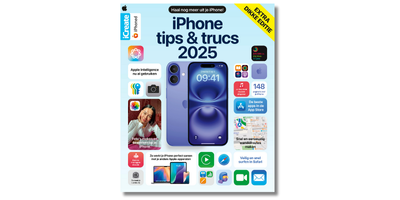In the dark, your pupils dilate, so you have to get used to light when you turn on your iPhone. With these iPhone tips you prevent that!
iPhone tips: Use the hidden red screen
The functions Night Shift, Dark mode, reducing white point and the little light zoom filter all help to reduce the harmful effects that clear iPhone screens can have at night on the biorhythm of your body. But there is even an option in iOS that turns your entire screen red.
You do that with the ‘color tint’ option. With this you cover the entire screen with a colored filter, in this case with pure red. Red light is more difficult to see than other light frequencies, so it makes our eyes think that it is less bright than it actually is. That means that you can look at a red screen in a dark room and that your dilated pupils hardly have to adjust to light. Conversely, your eyes also adapt much faster to the dark when you look away from the red screen.

Not just for when you are in bed
The hidden color filter is of course useful if you wake up at night. But the function could also be useful when using star card apps, or when you secretly look at your iPhone in the cinema. Many animals have difficulty seeing red, so in principle you can also use your iPhone with a red filter at night during hunting … We show you how it works:
1. Switch on color rint red
To start, call in the filter so that you can try out if it works for you. You do that as follows:
- Open the app settings;
- Tap ‘accessibility’ and then on ‘display and text size’;
- Scroll down and tap ‘color filters’;
- Switch on ‘color filters’ and tap ‘color tone’;
- Drag the scroll beams ‘intensity’ and ‘tint’ all the way to the right.

It is not possible to capture the effect in a screenshot, hence the (unfortunately not the best) photo. As you can see, the effect is quite dramatic. Be sure to try it out for a while in the dark. Because your iPhone only radiates red light, it is at least much easier to use it in the dark and thus keep your night view.
And switch off
It is of course not useful to follow the above steps every time you want to switch between the normal and the red screen. Fortunately that is not necessary either. We show you two options that you can choose from.


Discover even more tricks for your iPhone!
Dealing smarter with your iPhone has never been so easy with these indispensable tips for every user. The first magazine of iPhoned.
2. Switch on via the activation button
You can control the activation button by quickly pressing the side button of your iPhone three times. You can choose which functions you assign to it. You add the ‘color filters’ function as follows:
- Open the Settings app and tap ‘Accessibility’;
- Scroll down and tap ‘Activation button’;
- Place a check mark for ‘color filters’.

By pressing the side button of your iPhone three times quickly, you will switch on the red screen from now on. Press the red screen again three more times and you switch off again. If you have assigned multiple functions to the activation button, you also have to choose each time which function you want to switch on or off. If you don’t want that, you better choose the next option.
3. Switch on via the control panel
You can also add a controller to the control panel with which you can turn the color filter on and off. That works like this:
- Open the control panel (wipe down from the top right down);
- Tap at the top left of the plus sign (+);
- Tap down ‘Add a controller’;
- Scroll down and tap ‘Color filters’ (under ‘Seeing – Accessibility’).

If you now open the control panel and tap the ‘Color filters’ button (three circles), switch on the red screen or off.
More iPhone tips?
Did you like these iPhone tips and do you want more? On iPhoned Read useful tips and tricks for your iPhone every week. Check the most recent tips below!
-
iPhone tips: keep your night view with the hidden red screen
-
New on Netflix and Apple TV Plus: View our tips for May 2025
-
Share WiFi password with iPhone and Android via a QR code
-
Saving Spotify Data: The three best tips to spare your bundle
-
Object to Meta AI: This is how you do it on Facebook and Instagram